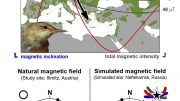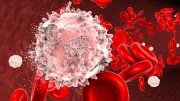
Engineers studying shape-shifting hydrogels can now create and predict complex shapes from these materials. Credit: Christine Daniloff
Hydrogels have been in the marketplace for a long time, offering diverse properties that make them ideal for applications on a number of consumer products. During the last few years, researchers started exploring their use in potential drug delivery applications but were lacking the control they needed, until now. A team of engineers studying the mechanics of shape-shifting hydrogels, report that they can now create and predict complex shapes from hydrogels.
The flexible properties of hydrogels — highly absorbent, gelatinous polymers that shrink and expand depending on environmental conditions such as humidity, pH and temperature — have made them ideal for applications from contact lenses to baby diapers and adhesives.
In recent years, researchers have investigated hydrogels’ potential in drug delivery, engineering them into drug-carrying vehicles that rupture when exposed to certain environmental stimuli. Such vesicles may slowly release their contents in a controlled fashion; they may even contain more than one type of drug, released at different times or under various conditions.
However, it’s difficult to predict just how hydrogels will rupture, and up until now it’s been difficult to control the shape into which a hydrogel morphs. Nick Fang, an associate professor of mechanical engineering at MIT, says predicting how hydrogels transform could help in the design of more complex and effective drug-delivery systems.
“What kind of shape is more efficient for flowing through the bloodstream and attaching to a cell membrane?” Fang says. “With proper knowledge of how gels swell, we can start to generate patterns at our wish.”
Fang and postdoc Howon Lee, along with colleagues at Arizona State University, are studying the mechanics of shape-shifting hydrogels: looking for relationships between a hydrogel structure’s initial shape, and the medium in which it transforms, in order to predict its final shape. In a paper to appear in Physical Review Letters, the researchers report that they can now create and predict complex shapes — including star-shaped wrinkles and waves — from hydrogels.
The findings may provide an analytical foundation for designing intricate shapes and patterns from hydrogels.
From PowerPoint to 3-D
To create various hydrogel structures, Fang and his collaborators used an experimental setup that Fang helped invent in 2000. In this setup, researchers project PowerPoint slides depicting various shapes onto a beaker of photosensitive hydrogel, causing it to assume the shapes depicted in the slides. Once a hydrogel layer forms, the researchers repeat the process, creating another hydrogel layer atop the first and eventually building up a three-dimensional structure in a process akin to 3-D printing.
Using this technique, the team created cylindrical shapes of various dimensions, suspending the structures in liquid to observe how they transformed. All cylinders morphed into wavy, star-shaped structures, but with characteristic differences: Short, wide cylinders evolved into structures with more wrinkles, whereas tall, slender cylinders transformed into less wrinkly shapes.
Fang concluded that as a hydrogel expands in liquid, various forces act to determine its final shape.
“This kind of tubular structure has two ways of deforming,” Fang says. “One is that it can bend, and the other is that it can buckle, or squeeze. So these two modes actually compete with each other, and the height tells how stiff it is to bending, while the diameter tells how easy it is to stretch.”
From their observations, the team drew up an analytical model representing the relationship between a structure’s initial height, diameter and thickness and its ultimate shape. Fang says the model may help scientists design specific shapes for more efficient drug-delivery systems.
Wrinkling naturally
Fang says the group’s results may also help explain how complex patterns are created in nature. He points to peppers — whose cross-sections can vary widely in shape — as a case in point: Small, spicy peppers tend to be triangular in cross-section, whereas larger bell peppers are more star-shaped and wavy. Fang speculates that what determines a pepper’s shape, and its number of waves or wrinkles, is its height and diameter.
Fang says the same principle may explain other intricate shapes in nature — from the creases in the brain’s cortex to wrinkles in fingerprints and other biological tissues that “leverage mechanical instability to create a wealth of complex patterns.”
Katia Bertoldi, an assistant professor of applied mechanics at Harvard University, says Fang’s analysis will allow scientists to control the expansion and collapsing of devices made from hydrogels and other soft materials.
“What is remarkable is there’s a match between theory and experimentation,” Bertoldi says. “You can use these calculations to fabricate new designs like drug-delivery systems and soft robotics. The system really offers new avenues for the design of these highly deformable objects.”
The team plans to study and predict more hydrogel shapes in the future to help scientists design drug vesicles that transform predictably.
Reference: “Prescribed Pattern Transformation in Swelling Gel Tubes by Elastic Instability” by Howon Lee, Jiaping Zhang, Hanqing Jiang and Nicholas X. Fang, 25 May 2012, Physical Review Letters.
DOI: 10.1103/PhysRevLett.108.214304
The research was supported by the National Science Foundation and Lawrence Livermore National Laboratory. Collaborators from Arizona State University include Jiaping Zhang and Hanqing Jiang.









Be the first to comment on "New Technique Predicts How Hydrogels Transform"